#marchantiophyta
Text
Phylum Round 1
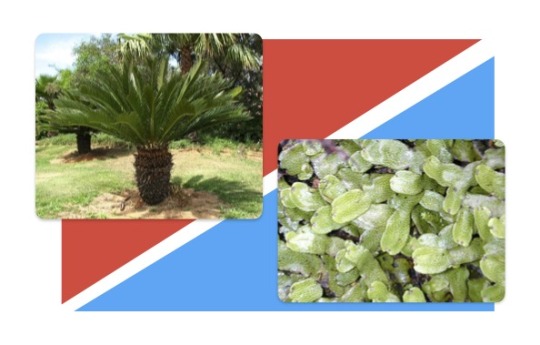
Not Quite Palms vs Not Quite Moss
Cycadophyta (cycads) -- while cycads look like palms, true palm trees are in magnoliophyta. Cycads are gymnosperms, meaning they have seeds but do not have flowers or fruit, and are most often pollinated by beetles. Many can grow in very low water conditions, some out of sand or even rock. Bread palms, a type of cycad, have edible stems. Cones of the Modjadji cycad can weigh more than 40 kg (88 pounds).
Marchantiophyta (liverworts): There are approximately 9,000 known species of liverworts, non-vascular (and therefor relatively small) plants with a dominant gametophyte stage, which can either have leaves or flat thalluses. The name comes from an ancient belief that they could be used to treat liver problems. Liverworts have important roles in the ecosystem: preventing the erosion of streambanks, collecting and retaining water in tropical forests, and forming soil crusts in deserts and polar regions.
#cycadophyta#marchantiophyta#plant taxonomy showdown#battle of the plants#phylum round 1#phylum#plant bracket#tumblr bracket#bracket tournament#poll bracket
86 notes
·
View notes
Text
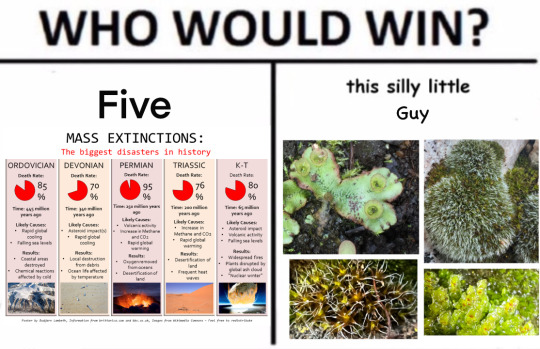
Oh and here’s a good note too… they can’t even get up and move. (Spoilers: the bryophytes won)
#who would win#bryophytes#the bryophytes win#moss#botany#mosscore#bryology#moss facts#bryophyta#botany facts#moss fact#science#botany meme#science meme#biology meme#hepatics#liverwort#marchantiophyta
133 notes
·
View notes
Text

Liverworts can do vape tricks
#botany#art#liverworts#bryology#marchantiophyta#ok ok it’s spore dispersal#but it LOOKS like vape tricks
71 notes
·
View notes
Photo

Liverworts (Marchantiophyta) are small, non-vascular plants with a fascinating lifecycle typical of the bryophytes, which include mosses and hornworts. Due to their small size and growth habit, these primitive beauties are often overlooked, but they’re actually quite common. I often find them growing in the “splash” zone of shady seeps and brooks, typically clinging to rock surfaces. There are two types of liverworts: thallose liverworts, whose scaly, flat surfaces branch out in a “Y” pattern; and leafy liverworts, which have overlapping, leaf-like scales arranged in at least two rows. The photo above is of snakeskin liverwort (Conocephalum salebrosum), a thallose liverwort I found growing in a seep along the Mon River Trail. As you might surmise, liverworts make dramatic show plants in terrariums, especially if you can get them to sprawl over a rock surface.
#appalachia#vandalia#west virginia#mon river trail#flora#non-vascular plants#bryophytes#marchantiophyta#liverworts#thallose liverwort#leafy liverwort#conocephalum salebrosum#snakeskin liverwort
104 notes
·
View notes
Text
#1877 - Lunularia cruciata - Crescent-cup Liverwort


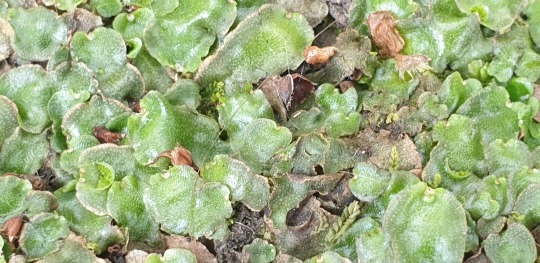
Spotted growing around the irrigation sprinklers in the gardens of the Melbourne Immigration Museum. The only species in the genus Lunularia and family Lunulariaceae. As with the spleenworts, the common name is derived from their shape and imagined usefulness against liver complaints (often themselves imagined).
A robust and hardy thallose liverwort, common in shady damp spots in gardens. It resembles the better-known Marchantia, but in this liverwort the gemma cups are crescent-shaped rather than circular (hence 'lunularia'). Gemma cups contain modified clumps of tissue - gemmae - that can be splashed out by raindrops to become new plants. Probably originally native to Europe, and around the Mediteraanean, where the sexual forms (cross-shaped, hence 'cruciata') are most common. In other parts of the world, it relies more on asexual reproduction via gemmae.
Liverworts are typically small, with individual plants less than 10 cm long, but some species can cover large patches of ground, or whatever substrate they prefer. Most of the 9000 estimated species are found in humid locations although there are aquatic, desert and Arctic species. Some species are minor weeds in shady greenhouses or gardens.
4 notes
·
View notes
Text

9/27/22
0 notes
Note
what's a slime mould and liverwort?
Liverwort sounds like something a witch would brew in her cauldron alongside eye of newt (that's mustard seed right?) and such lol
liverworts are members of the plantae division marchantiophyta :-) here is are two photos !!
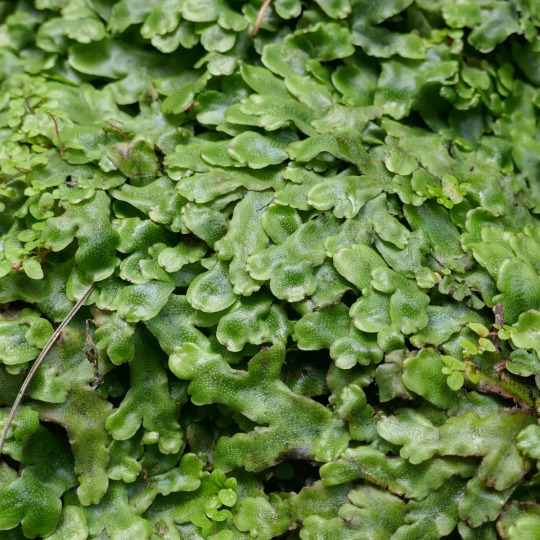
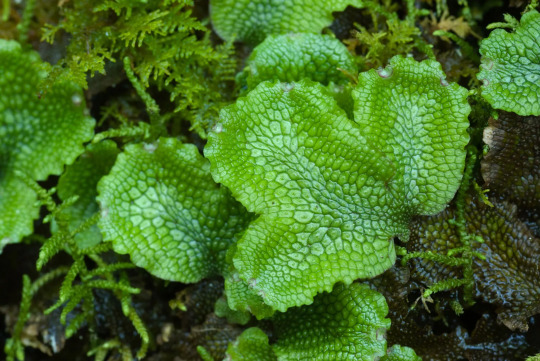
<3
slime moulds are amoebas that come together to form little structures <3 they were thought to be fungi for a long time, but are now grouped with protists. there is a huge variety of different types !!

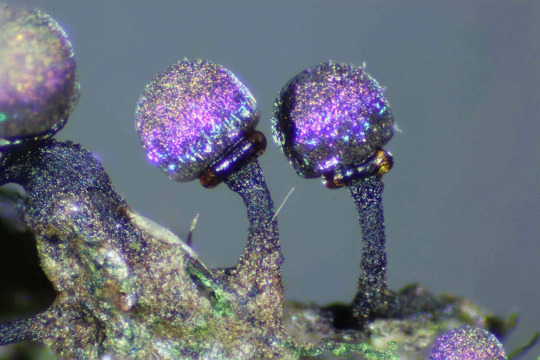
#sorry i don't have enough spoons to write images descriptions so these will remain#undescribed#• askbox replies: •#(ask : luminousmoon21)
44 notes
·
View notes
Text
rapper who is a nonvascular plant from the division Marchantiophyta call that paradox liverwort
0 notes
Text
Marsupella lusitanica (Gymnomitriaceae, Marchantiophyta), a New Species of Sect. Ustulatae from Mountain Ranges of Portugal
Pubmed: http://dlvr.it/SmR2xy
0 notes
Text
Phylum Round 2

Liverworts vs Ginkgo Biloba
Marchantiophyta: moss-like non-vascular plants. Some aquatic liverworts are sold for use in aquariums.
Ginkgophyta: The one surviving species of this phylum, Ginkgo biloba, is used in traditional Chinese medicine and as an ornamental plant around the world.
#marchantiophyta#ginkgophyta#plant taxonomy showdown#battle of the plants#phylum round 2#phylum#plant bracket#tumblr bracket#bracket tournament#poll bracket
51 notes
·
View notes
Text
BRIÓFITAS
Briófitas são plantas de pequeno porte encontradas principalmente em áreas úmidas. Musgos, hepáticas e antóceros são exemplos de briófitas.
•Briófitas são plantas avasculares que apresentam como representantes musgos, hepáticas e antóceros.
•Briófitas são plantas avasculares.
•Alguns musgos apresentam células especializadas na condução de substâncias.
•Briófitas não possuem semente, flores e frutos.
•No ciclo de vida de uma briófita, a fase de gametófito é dominante.
•Para que os anterozoides atinjam a oosfera, é fundamental a presença de água.
•As briófitas atuais são divididas em três filos: Marchantiophyta, Bryophyta e Anthocerophyta.

0 notes
Text
Source
#marchantiophyta#liverwort#mosscore#bryophytes#botany#botany memes#polls#hyper specific poll#botany poll#science#botany facts#liverwort facts
44 notes
·
View notes
Text
Las plantas hepáticas

Las hepáticas son un grupo de plantas con entre 5000 y 8000 especies (CrandallStotler et al., 2009; Von Konrat et al., 2010) incluidas en 330 a 391 géneros. La división presenta dos tipos morfológicos: talosas y foliosas. La fase dominante es la gametofítica y la dependiente es la esporofítica, crecen principalmente en taludes húmedos y sombreados, aunque también pueden habitar en zonas áridas y árticas. La mayoría son terrestres, aunque también hay representantes epífitos o acuáticos.
Hepáticas talosas:
Los gametofitos (mira abajo significado) de las hepáticas talosas tiene el cuerpo aplanado, ramificado dicotómicamente y lobulado en el ápice; anatómicamente pueden presentar una o varias capas de grosor poco diferenciadas entre si, o distinguirse una epidermis superior, una zona con abundantes cloroplastos, una región mas gruesa e incolora que funciona como tejido de almacenamiento y una epidermis inferior en donde se desarrollan los rizoides y las escamas.
En algunas especies de hepáticas talosas los órganos sexuales, anteridios y arquegonios, se encuentran embebidos en cámaras especiales que se localizan en la superficie dorsal del talo (Ricciocarpus). En otros grupos (Marchantia) hay ramas del talo gametofítico llamadas gametangióforos, constituidas por un pedúnculo cilíndrico y un receptáculo discoide con simetría más o menos radial, en el que se desarrollan anteridios y arquegonios; las ramas portadoras de anteridios se conocen como anteridióforos y las que portan arquegonios son llamadas arquegonióforos. Generalmente los gametangióforos de diferente sexo se encuentran en talos separados.
El esporofito en las hepáticas talosas está formado por un pie unido al gametofito, una seta muy corta, en cuyo ápice se encuentra una cápsula o esporangio cubierto en la etapa juvenil por la calíptra (restos de la pared del arquegonio).
Dentro de la cápsula madura, además de las esporas meióticas, con frecuencia se encuentran pequeños filamentos higroscópicos llamados eláteres, que se originan de una parte del tejido esporógeno y cuya función es ayudar a la dispersión de las esporas.
Hepáticas foliosas:
Las hepáticas foliosas son plantas pequeñas y ramificadas, que se caracterizan porque sus gametofitos están constituidos por un eje principal o tallo (caulidio), en el cual se insertan dos hileras de hojas laterales (filidios) y, en ocasiones, una hilera ventral de hojas más pequeñas (anfigastros). Los gametofitos se fijan al sustrato por rizoides generalmente unicelulares.
Los anteridios y arquegonios se localizan en ramas laterales cortas o en el tallo principal. Los arquegonios están rodeados por un periquecio o por un tubo formado por la fusión de hojas en forma de cáliz denominado “perianto”. Los anteridios son esféricos y se localizan con frecuencia en las axilas de las hojas perigoniales reducidas, en ramas especializadas.
El esporofito es erecto, con una larga seta y una cápsula esférica con pared pluriestratificada, misma que al madurar se abre en cuatro valvas.
El grupo, en general, presenta propagación vegetativa por fragmentación del talo o por yemas (propágulos) que se encuentran frecuentemente en el margen de las hojas (filidios) o en el ápice de los tallos (caulidios) o en estructuras especializadas denominadas conceptáculos.
Una característica diagnóstica de las hepáticas, que se observa en la mayoría de las especies, es la presencia de cuerpos oleíferos, de tamaño, forma y número variables, los cuales deben ser observados en el material fresco, ya que se pierden una vez que se seca o fija. Otro carácter de utilidad taxonómica, es la presencia o ausencia, de engrosamientos en la pared celular, los cuales reciben
el nombre de trígonos.
Las hepáticas fueron consideradas durante algún tiempo como la clase Hepaticae (Scagel et al., 1965) o Marchantiopsida (Parihar, 1962) de la división Bryophyta, sin embargo, estudios recientes han coincidido en determinar que se trata de una división independiente.

Divisiones Briofitas y Pteridofitas:
- División Marchantiophyta
- División Anthocerotophyta
- División Bryophyta
- División Psilotophyta
- División Lycophyta
> Familia Lycopodiaceae
> Familia Selegineallaceae
> Familia Isoëtaceae
- División Equisetophyta
- División Polypodiophyta
> Helechos eursporangiados
> Helechos lepetosporangiados
El gametófito: es descendiente de un individuo adulto fértil de la generación diploide (llamado esporófito), y a su vez tendrá descendientes directos que también serán diploides (esporofitos).
http://debazan.es/clasificacion-de-las-plantas/
Fuente:Resumido,y aprendiendo gracias a ellos.
Dra. Minerva Muñoz Gutiérrez †
Departamento de Biología de la
Reproducción de Mexico.
Read the full article
0 notes
Photo

Marchantia polymorpha - porostnica wielokształtna #marchantiapolymorpha #marchantiophyta #marchantiopsida #flowers #flower #petal #petals #nature #beautiful #love #pretty #plants #blossom #sopretty #spring #summer #flowerstagram #flowersofinstagram #flowerstyles_gf #flowerslovers #flowerporn #botanical #floral #florals #insta_pick_blossom #flowermagic #instablooms #bloom #blooms #botanical #floweroftheday
#insta_pick_blossom#flowerstagram#flower#flowersofinstagram#love#summer#spring#botanical#bloom#blossom#blooms#flowerporn#floral#marchantiopsida#beautiful#marchantiophyta#floweroftheday#flowerstyles_gf#petal#marchantiapolymorpha#flowermagic#pretty#sopretty#plants#florals#flowers#petals#instablooms#flowerslovers#nature
2 notes
·
View notes
Photo
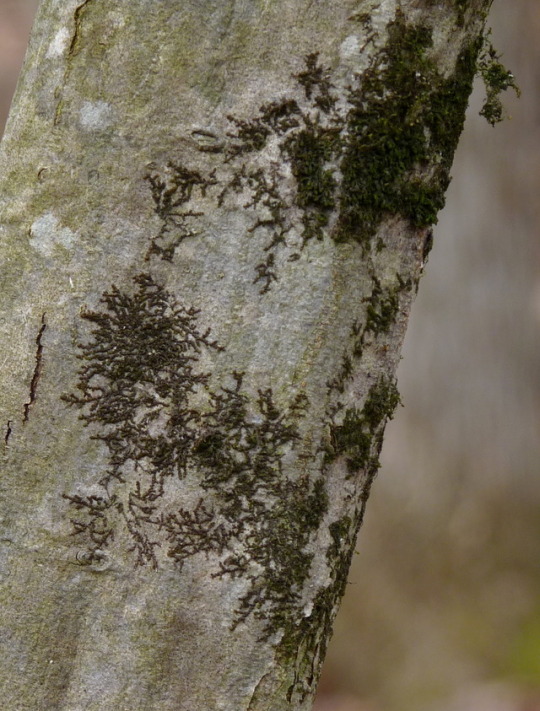
Frullania (a liverwort) on American Hornbeam (by me)
#Frullania#Jubulaceae#Jungermanniales#Jungermanniopsida#Marchantiophyta#liverwort#plants#trees#bark#spring#Great Swamp NWR#Great Swamp National Wildlife Refuge#Morris County#New Jersey#mine
20 notes
·
View notes
